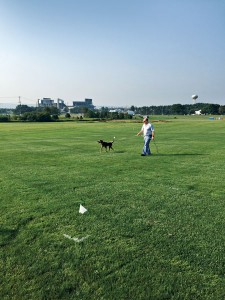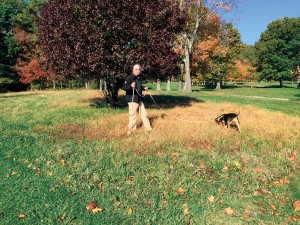Sniffing out ABWs: Using pooches to find a pest
Over the span of nearly half a century, the annual bluegrass weevil (ABW) or “Hyerodes weevil” (Listronotus maculicollis), has become the most important insect pest of golf course turfgrass in the northeastern U.S. and eastern Canada.
The last decade has brought drastic changes in how the pest is managed, as well as its dispersal into new regions. The challenges superintendents face in managing ABW differ by region and/or the years spent battling the pest. It’s not unusual for superintendents in the epicenter of the weevil’s distribution (the metropolitan New York City area) to have intensely managed their populations with chemical insecticides for more than three decades. Turfgrass managers in these areas are most concerned with ABW populations developing resistance to insecticides.
Conversely, superintendents in the southern range of the insect’s distribution, who have more recently become acquainted with the pest, may be more concerned with determining when and where the pest will strike. Both situations demonstrate an urgent need to develop novel monitoring technologies capable of accurately and reliably detecting ABW in different stages, population densities and times of the year. Without such a technology the frequency of blanket applications of preventive insecticides likely will increase, and in turn lead to more widespread insecticide resistance issues.
Management difficulties
ABW management is difficult because the insect is relatively small (0.2 inch), has cryptic stages (e.g. early-instar larvae are stem borers) and is nocturnal. These factors make detection of damaging densities in established populations difficult, they make assessing chemical control on large scales impractical, and make detection of the pest in new regions nearly impossible.
Superintendents managing ABW often choose to make preventive insecticide applications to avoid larval feeding damage to high-valued turf areas, targeting the adults as they move onto playing surfaces in the spring. It’s not uncommon for turfgrass managers to make between six and 10 insecticide applications throughout the year with broad-spectrum, short-residual insecticides. Consequently, ABW on many courses have developed resistance to the pyrethroids, an efficacious and economical class of insecticides in ABW management.
Making matters worse, it appears that several ABW populations with high levels of resistance also are insensitive to applications of unrelated insecticides (called “multiple resistance”). Superintendents managing multiple-resistant populations have few effective control options and often resort to making more frequent chemical insecticide applications in hopes of achieving even moderate reductions in densities.
Each year, courses without a previous history of ABW damage experience substantial turf loss without warning. The ability to detect ABW populations early in the invasion into new regions is critical in slowing the spread of this insect, and is vital in determining the value of taking action when population densities are low.
To do so requires an accurate and reliable means of detecting a small, mobile and nocturnal adult insect and/or its minute, hidden immature stages. We have many ways to sample insect populations and have made great strides in using available techniques to predict outbreaks.
However, the use of traditional sampling techniques (e.g. soil coring, salt flushes, vacuuming) is not a practical approach to detecting ABW populations that are patchily distributed in low densities across a golf course or a region.
To overcome this challenge, our laboratory at Penn State University has been working with canine handlers to determine if working dogs can effectively and reliably locate ABW populations in different habitats around the golf course.
![A conical tube, or “hide,” used in field trials to assess canine ability to detect annual bluegrass weevils (ABW). Each tube contained a scent treatment (ABW, a non-target insect control [Japanese beetle], or a blank [P. annua alone]).](https://www.golfdom.com/wp-content/uploads/2016/02/FIG1-IMG_4297_web-225x300.jpg)
FIGURE 1: A conical tube, or “hide,” used in field trials to assess canine ability to detect annual bluegrass weevils (ABW). Each tube contained a scent treatment (ABW, a non-target insect control [Japanese beetle], or a blank [P. annua alone]).
Most people associate these scent-detecting canines with locating missing persons or cadavers, detecting explosives or searching for illegal drugs. However, there has been a proliferation of studies over the last decade examining the use of canines to detect a diverse array of odors, including locating invasive reptiles, endangered species, toxic gases and even cancerous cells in humans.
A dog’s sense of smell is estimated to be 10,000 to 100,000 times greater than that of humans, and is capable of detecting extremely low (1 to 2 parts per trillion) odorant concentration levels. Their olfactory powers make canines ideal candidates to detect pests that otherwise could be missed by visual identification, especially in instances where the pest occurs in low densities, has hidden stages or is located in hard-to-access places. These attributes have allowed canines to become hallmarks in monitoring for bedbugs and termites in residential and commercial properties.
Proof of concept: Controlled field trials studies
My first day in my new position at Penn State coincided with the 2014 Penn State Turf Field Day. It was here that I met Jason Webeck of Good Night, Sleep Tight, Bun Montgomery of the J.K. Canine Academy and Scentworx in Alachua, Fla. Webeck operates a canine scent-detection company in western Pennsylvania and was in attendance to determine the turf industry’s interest in canines for pest monitoring. He performed a demonstration with one of their bedbug-detecting dogs, using “hides” or bedbugs in vials randomly distributed throughout a field. I found the concept to be interesting and agreed to supply Webeck with ABW throughout 2015 in exchange for the chance to test the dog(s) in a controlled, scientifically designed experiment.
We vacuum-collected ABW from tees and fairways weekly throughout the spring and early summer to assist in training a four-year old male beagle named Carl.
By August 2015 the handlers believed Carl had enough training and was ready for evaluation. We didn’t share the trial’s experimental design with the handlers until the day of the evaluation. It was important to us that the dog would be able to detect live ABW, discriminate the scent from that of other turfgrass insects and be able to detect the scent in turf with different heights of cut.
ABW adults were placed into 50-mL conical tubes containing P. annua and randomly sunk in the ground, flush with the soil surface in fairway-height P. annua or rough-height Kentucky bluegrass (Poa pratensis). The container was fitted with a mesh top to allow odors — but not weevils — to escape (Figure 1). We interspersed negative controls (Japanese beetles on P. annua, P. annua alone) among the tubes containing ABW to ensure that the dog was not alerting to other insects, the presence of the tube or the turfgrass.

FIGURE 2: Carl is led by his handler (Bun Montgomery) through rough-height turf in search of ABW in controlled field trials.
Carl was led by the handler through different sections of turf and observed by the evaluator (our lab) for a signal (scent detection, Figure 2). Carl alerted to an odor by sitting on the turf. Once a signal was given, the handler checked with the evaluator to determine whether ABW were present. If ABW were present in the vial (as noted by code dots), we recorded the indication as positive. We recorded a false positive if a signal was given and the conical contained either the Japanese beetle or the Poa annua blank.
Carl was capable of detecting a high percentage of the ABW hides in our first trial (76 percent positive indication, 24 percent false positives). Neither the individual replicate size (search area per sample) nor turfgrass height had any effect on the dog’s ability to detect ABW.
The first trial was a learning experience for both parties, and slight adjustments were made both in Carl’s training and our experimental design before a second controlled field trial in September. Some changes were made to increase Carl’s stamina to work longer on a trail and to avoid non-target insect scents. The results were dramatic.
Not only did Carl’s positive indication rate soar to 88 percent (12 percent false positives), but he was capable of finding the hides more quickly than before. The results are encouraging and demonstrate that canines can discriminate ABW odors from other insects or plants in turfgrass settings, and that their performance can be substantially improved through training.
The search for overwintering sites
In addition to the controlled field trials, we evaluated Carl’s ability to detect natural, overwintering ABW populations on golf courses in late October and November. Understanding where overwintering sites are located could allow superintendents to make spot treatments, thus reducing unnecessary applications and saving potentially thousands of dollars annually.

FIGURE 3: Carl investigates a potential ABW overwintering site at Sinking Valley Country Club in Altoona, Penn. Using canines to identify ABW overwintering sites may lead to greater precision management in spring.
Carl was led through different areas of the golf course, from fairways and greens to roughs and tree lines. ABW were detected in all of the environments that we have come to regard as traditional overwintering sites, such as leaf litter, bases of trees and under shrubs along wood lines (Figure 3). Carl made several detections deep in the woods, including many that were more than 50 yards away from fairways. Surprisingly, he also made positive indications in roughs and fairways, areas not typically believed to be potential overwintering sites.
The results from these experiments will not be complete until we are able to perform pitfall trapping in the spring to assess population sizes and spatial distributions. We will then have a better understanding of how effective Carl was in locating overwintering sites, if the density of weevils within a site had an effect on detection, and whether or not overwintering “hotspots” were overlooked.
The future of scent-detecting canine research
These initial studies have reduced my skepticism about the use of canines in insect detection, but more work is needed before canines become a regular fixture in ABW monitoring and management.
Our work with Good Night, Sleep Tight and Scentworx is an encouraging start, but we need more controlled field trials and real-world assessments to ascertain the reliability of the technology. Additionally, should the concept prove to be effective, the industry will need more dogs to meet demand. Over the next several years we will continue our trials and evaluate new canines as they become available. I look forward to reporting on that research, which we hope will benefit superintendents and improve our understanding of ABW behavior and population dynamics.
Photos: Ben McGraw









